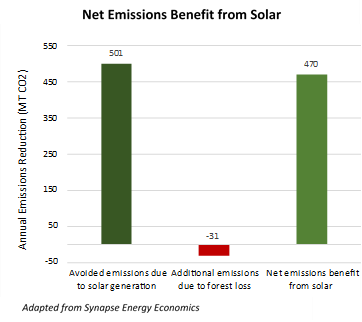Summary:
With the power mix that we have today, solar arrays are significantly more effective at reducing carbon pollution than an equivalently sized block of New England forest. The electricity generated by new solar facilities largely displaces electricity from natural gas power plants throughout New England. The emissions savings from reducing this dirty generation exceed the carbon sequestration that is lost by converting forestland to site solar. Nonetheless, solar has a relatively modest impact on Vermont’s forest cover which is primarily threatened by residential development.
Growing forests naturally combat climate change by absorbing and storing carbon dioxide. The natural climate change-fighting capacity that trees provide has led some people to the mistaken conclusion that cutting trees to install solar panels harms the climate. The truth is that when it comes to climate change, converting woodlands to solar arrays is a significant win. While forests reduce the amount of CO2 in the atmosphere, given New England’s power mix, acre-for-acre, solar panels are significantly more effective at climate change mitigation than a typical New England forest. This does not provide a blank check to cut trees to build solar. REV recognizes that many forest blocks provide critical habitat, recreational, or economic benefits and ought to be protected for those reasons. But stopping the deployment of solar power because some trees will be removed in the process is not a win in the fight against climate change.
Forest Conversion Carbon Balance
 In 2021, Synapse Energy Economics published a detailed breakdown of the carbon balance of converting New England forest to solar which showed that converting an acre of typical New England forestland to solar saved 470 tons of CO2 annually. The climate benefits of solar were more than 15 times that of forestland, reflecting just how dirty our current electricity generation is and how efficient solar arrays have become. Throughout New England, natural gas power plants are typically the power plants that are operating “on the margin” – that is they are the plants that ramp up or down in response to changes in demand or renewable generation. Reducing power generation from these carbon-intensive plants results in massive greenhouse gas benefits, resulting in a very favorable carbon balance for solar. The carbon balance will not shift in favor of maintaining forest cover until the marginal emissions rate in New England is reduced by 94%. While forests sequester and store carbon, the emissions that solar offsets are so large that the net impact of clearing trees for solar is a substantial reduction in net greenhouse gas emissions.
In 2021, Synapse Energy Economics published a detailed breakdown of the carbon balance of converting New England forest to solar which showed that converting an acre of typical New England forestland to solar saved 470 tons of CO2 annually. The climate benefits of solar were more than 15 times that of forestland, reflecting just how dirty our current electricity generation is and how efficient solar arrays have become. Throughout New England, natural gas power plants are typically the power plants that are operating “on the margin” – that is they are the plants that ramp up or down in response to changes in demand or renewable generation. Reducing power generation from these carbon-intensive plants results in massive greenhouse gas benefits, resulting in a very favorable carbon balance for solar. The carbon balance will not shift in favor of maintaining forest cover until the marginal emissions rate in New England is reduced by 94%. While forests sequester and store carbon, the emissions that solar offsets are so large that the net impact of clearing trees for solar is a substantial reduction in net greenhouse gas emissions.
Synapse’s results are consistent with other analyses as well. The Columbia Climate School published an assessment of the carbon balance of converting forestland in Virginia to solar and concludes that the conversion would reduce annual emissions by 120 – 137 tons per year. The Sierra Club and Energy Sage have both examined cutting individual trees for residential solar arrays and found that the carbon balance tips definitively in favor of solar.
The overall picture on climate is clear: solar arrays are significantly more effective at reducing carbon pollution than trees are with the power mix that we have today.
Solar Development and Forestland in Vermont
Large contiguous blocks of forest offer unique habitat benefits and protecting these areas is especially important. Fortunately, solar development is rarely, if ever, sited in these areas. It is most cost-effective to build solar facilities near existing infrastructure and load centers. Consequently, solar development typically takes place near existing roads and power lines and adjacent to existing development rather than in unbroken forests.
While there are estimates that Vermont’s forest cover is declining by as much as 1,500 acres per year, this is overwhelmingly attributable to “suburban and rural residential sprawl” according to research by the University of Vermont. In contrast, the Agency of Natural Resources reported that all net-metered solar projects built in the four years between July 2017 and July 2021 resulted in only 208 acres of forest clearing. In addition, unlike forms of development that permanently remove land from natural habitat, solar projects have a 20 to 25-year lifetime after which the site can be restored or repowered with more efficient solar panels. Though ANR does not report the amount of forest clearing resulting from other types of solar projects, it is clear that new residential development impacts far more forestlands than renewable energy projects do.
